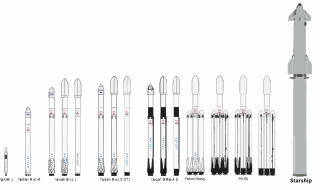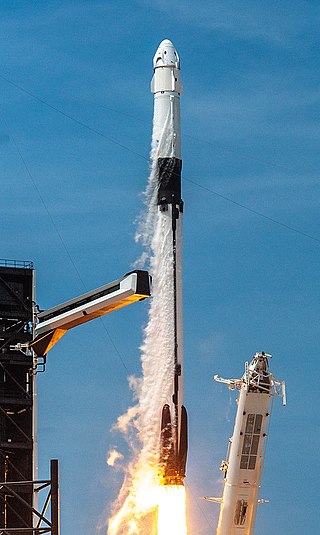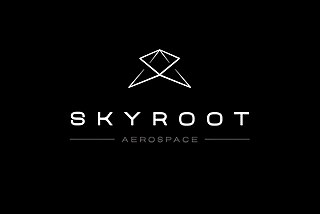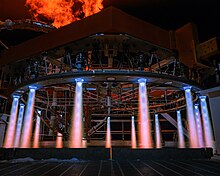
The aerospike engine is a type of rocket engine that maintains its aerodynamic efficiency across a wide range of altitudes. It belongs to the class of altitude compensating nozzle engines. Aerospike engines were proposed for many single-stage-to-orbit (SSTO) designs. They were a contender for the Space Shuttle main engine. However, as of 2023 no such engine was in commercial production, although some large-scale aerospikes were in testing phases.

A reusable launch vehicle has parts that can be recovered and reflown, while carrying payloads from the surface to outer space. Rocket stages are the most common launch vehicle parts aimed for reuse. Smaller parts such as rocket engines and boosters can also be reused, though reusable spacecraft may be launched on top of an expendable launch vehicle. Reusable launch vehicles do not need to make these parts for each launch, therefore reducing its launch cost significantly. However, these benefits are diminished by the cost of recovery and refurbishment.

Space Exploration Technologies Corporation, commonly referred to as SpaceX, is an American spacecraft manufacturer, launch service provider and satellite communications company headquartered in Hawthorne, California. The company was founded in 2002 by Elon Musk with the goal of reducing space transportation costs and ultimately developing a sustainable colony on Mars. The company currently produces and operates the Falcon 9 and Falcon Heavy rockets along with the Dragon and Starship spacecraft.

Blue Origin Enterprises, L.P., commonly referred to as Blue Origin is an American aerospace manufacturer, defense contractor, launch service provider and space technologies company headquartered in Kent, Washington, United States. The company makes rocket engines for United Launch Alliance (ULA)'s Vulcan rocket and manufactures their own rockets, spacecraft, satellites, and heavy-lift launch vehicles. The company is the second provider of lunar lander services for NASA's Artemis program and was awarded a $3.4 billion contract. The four rocket engines the company has in production are the BE-3U, BE-3PM, BE-4 and the BE-7.

Falcon 9 is a partially reusable medium-lift launch vehicle that can carry cargo and crew into Earth orbit, designed, manufactured and launched by American aerospace company SpaceX. It can also be used as an expendable heavy-lift launch vehicle. The first Falcon 9 launch was on 4 June 2010. The first Falcon 9 commercial resupply mission to the International Space Station (ISS) launched on 8 October 2012. In 2020 it became the first commercial rocket to launch humans to orbit and remains the only such vehicle. It is the only U.S. rocket certified for transporting humans to the ISS. In 2022, it became the U.S. rocket with the most launches in history and with the best safety record, having suffered just one flight failure.

SpaceX manufactures launch vehicles to operate its launch provider services and to execute its various exploration goals. SpaceX currently manufactures and operates the Falcon 9 Block 5 family of medium-lift launch vehicles and the Falcon Heavy family of heavy-lift launch vehicles – both of which are powered by SpaceX Merlin engines and employ VTVL technologies to reuse the first stage. As of 2024, the company is also developing the fully reusable Starship launch system, which will replace the Falcon 9 and Falcon Heavy.

Electron is a two-stage, partially reusable orbital launch vehicle developed by Rocket Lab, an American aerospace company with a wholly owned New Zealand subsidiary. Electron services the commercial small satellite launch market. As of May 2024, it's the third most launched small-lift launch vehicle in history. Its Rutherford engines are the first electric-pump-fed engine to power an orbital-class rocket. Electron is often flown with a kickstage or Rocket Lab's Photon spacecraft. Although the rocket was designed to be expendable, Rocket Lab has recovered the first stage twice and is working towards the capability of reusing the booster. The Flight 26 (F26) booster has featured the first helicopter catch recovery attempt.

New Glenn is a heavy-lift orbital launch vehicle developed by Blue Origin, named after NASA astronaut John Glenn, the first American astronaut to orbit Earth. New Glenn is a two-stage rocket with a diameter of 7 m (23 ft). Its first stage is powered by seven BE-4 engines that are also designed and manufactured by Blue Origin. It is intended to launch from Cape Canaveral Launch Complex 36, with the first stage landing on a barge in Port Canaveral.The inaugural vehicle was unveiled on the launch pad in February 2024.

Firefly Alpha is a two-stage orbital expendable launch vehicle developed by the American company Firefly Aerospace to compete in the commercial small satellite launch market. Alpha is intended to provide launch options for both full vehicle and rideshare customers.
LinkSpace or Link Space Aerospace Technology Inc. is a Chinese private space launch company based in Beijing. It is led by CEO Hu Zhenyu, and founded as the first private rocket firm in China. The company was founded in 2014, by Hu Zhenyu, a graduate of South China University of Technology; Yan Chengyi, a graduate of Tsinghua University; and Wu Xiaofei, a manufacturing expert. The company is registered in Shenzhen.

Starship is a two-stage super heavy-lift launch vehicle under development by SpaceX. As of May 2024, it is the largest and most powerful rocket ever flown. Starship's primary objective is to lower launch costs significantly via economies of scale. This is achieved by reusing both rocket stages, increasing payload mass to orbit, increasing launch frequency, creating a mass-manufacturing pipeline, and adapting it to a wide range of space missions. Starship is the latest project in SpaceX's decades-long reusable launch system development program and ambition of colonizing Mars.

Falcon 9 Block 5 is a partially reusable two-stage-to-orbit medium-lift launch vehicle designed and manufactured in the United States by SpaceX. It is the fifth version of Falcon 9 Full Thrust, powered by SpaceX Merlin engines burning rocket-grade kerosene (RP-1) and liquid oxygen (LOX).

Raptor is a family of rocket engines developed and manufactured by SpaceX. The engine is a full-flow staged combustion cycle (FFSC) engine powered by cryogenic liquid methane and liquid oxygen ("methalox").

Skyroot Aerospace Private Limited is an Indian private aerospace manufacturer and commercial launch service provider headquartered in Hyderabad, Telangana. The company was founded by former engineers and scientists from ISRO. It aims to develop and launch its own series of small-lift launch vehicles especially crafted for the small satellite market.

AgniKul Cosmos Private Limited is an Indian aerospace manufacturer based in National Center for Combustion R&D (NCRD) of IIT Madras, Chennai. The start up aims to develop and launch its own small-lift launch vehicle such as the Agnibaan, capable of placing 100 kg (220 lb) payload into a 700 km (430 mi) orbit. The first commercial launch was expected in 2022. However, no launch happened in that year. The first suborbital mission will be conducted on 22 March 2024. This did not happen either. The company tried twice to launch its suborbital rocket in March and April but postponed due to technical issues.
Terran R is a heavy-lift two-stage, partially reusable launch vehicle under development by Relativity Space. The vehicle is partially constructed with 3D printing technologies, like its predecessor, the small-lift Terran 1. The first flight is expected to be in 2026.
Terran 1 was an expendable two-stage small-lift launch vehicle developed by Relativity Space. Development began in 2017 and the rocket was retired in 2023. Most structures and components of the vehicle are manufactured with 3D printing processes.

Space Pioneer, also known as Beijing Tianbing Technology Co., Ltd., is a Chinese aerospace company developing reusable orbital rocket technology—both launch vehicles and liquid rocket engines—to access the market for low-cost space launch services. The company is aiming to meet launch requirements for both the Chinese national satellite internet project and also the CNSA solicitation for resupply of the Tiangong space station.
Nova is a fully reusable medium-lift launch vehicle being developed by Stoke Space that was announced in mid 2021. It is planned to be a two-stage fully reusable launch vehicle with a planned payload capacity of 5T (5,000kg) into LEO. It will use seven engines consuming LNG/LOX for the first stage and a hydrolox engine with 30 thrust chambers arranged in a ring around a regeneratively cooled heatshield, eliminating the need for brittle thermal tiles like on the Space Shuttle. For its reusable first stage, the company is considering 7 conventional full-flow-staged combustion rocket engines, burning methalox. This configuration is very similar to SpaceX's Raptor Engine. The first stage performs an RTLS landing much like SpaceX's Falcon 9 and Starship's first stage, as well as Rocket Lab's planned Neutron.
Jiuzhou Yunjian, also known as JZYJ, is a Chinese rocket engine design and production startup based in Beijing.
















